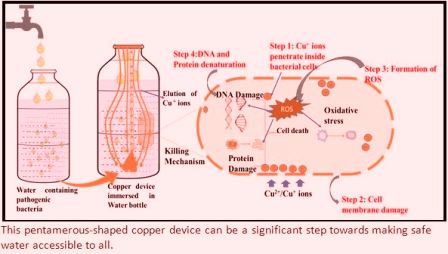Researchers Develop Copper-Based Low-Cost Water Purification Device
The device is based on the surface-to-volume ratio of copper for improving the quality of stored drinking water.
Demand for pure drinking water has been increasing steadily for the last few decades. With technological advancements, numerous commercial water purifiers have appeared in the market. However, in an attempt to purify water, most of these also eliminate the necessary oligo-dynamic minerals vital for our health. Widespread use of plastic containers for storing water, which does not possess antibacterial and purification properties, has added to the problem.
technological advancements, numerous commercial water purifiers have appeared in the market. However, in an attempt to purify water, most of these also eliminate the necessary oligo-dynamic minerals vital for our health. Widespread use of plastic containers for storing water, which does not possess antibacterial and purification properties, has added to the problem.
Copper’soligo-dynamic properties, antimicrobial, antioxidant, alkalizing/pH balance, and high electrical and thermal conductivity make it the best candidate for water purification. A team of researchers from the CSIR-Central Scientific Instruments Organization (CSIR-CSIO) and the CSIR-Institute for Microbial Technology (CSIR-IMTech), has developed an antimicrobial water purifying device that is simple to fit into any wide-mouth opening water bottle.
The device is based on the surface-to-volume ratio of copper to improve the quality of stored drinking water. It is efficient against microbiological contamination and enhances the water’s quality with minerals. The novel design of the copper ionic device makes it a good option for travellers, office goers, children, campaigns, homes, outdoor, on-site personnel, hikers, etc.
It has a simple and robust operation; does not need batteries; has an uncomplicated assembly that can be scaled up at a meagre manufacturing cost; portable; can be reused; environment-friendly; chemically resistant, and aesthetically pleasing.
“The device is active against the Gram (-) and Gram (+) bacteria. The device was tested against S. aureus, Vibrio cholera, Salmonella typhi, P.aeruginosa, and E. coli according to the WHO, IS-10500(2012) standards. This device found no microbial growth in less than 2 hours of water storage. The release of active copper is <2.0 ppm, which is within the permissible limit of copper in drinking water,” say the researchers.
They have also noted that the physical parameters (pH, EC, TDS, and salinity) remain within the permissible limit after the copper device’s intervention, making it amenable for public use. The antimicrobial copper device reduces the transmission of microbes through the contact-killing mechanism and therefore increases immunity.
Dr Neelam Kumari informs, “the developed copper device releases the copper ions over time. The released copper interacts with germs and prevents the spread of pathogens through the bacterial membrane damage during contact, thus offering the microbially safe drinking water.”
The research team comprised Dr Srinivasan Krishnamurthi, Principal Scientist (CSIR-IMTECH); Dr Neelam Kumari, Principal Scientist, CSIR-CSIO; Prachi Arora (CSIO); and Suman Tewary (CSIR-National Metallurgical laboratory).
The study’s findings have been published in the Journal of Water Process Engineering. (India Science Wire)
